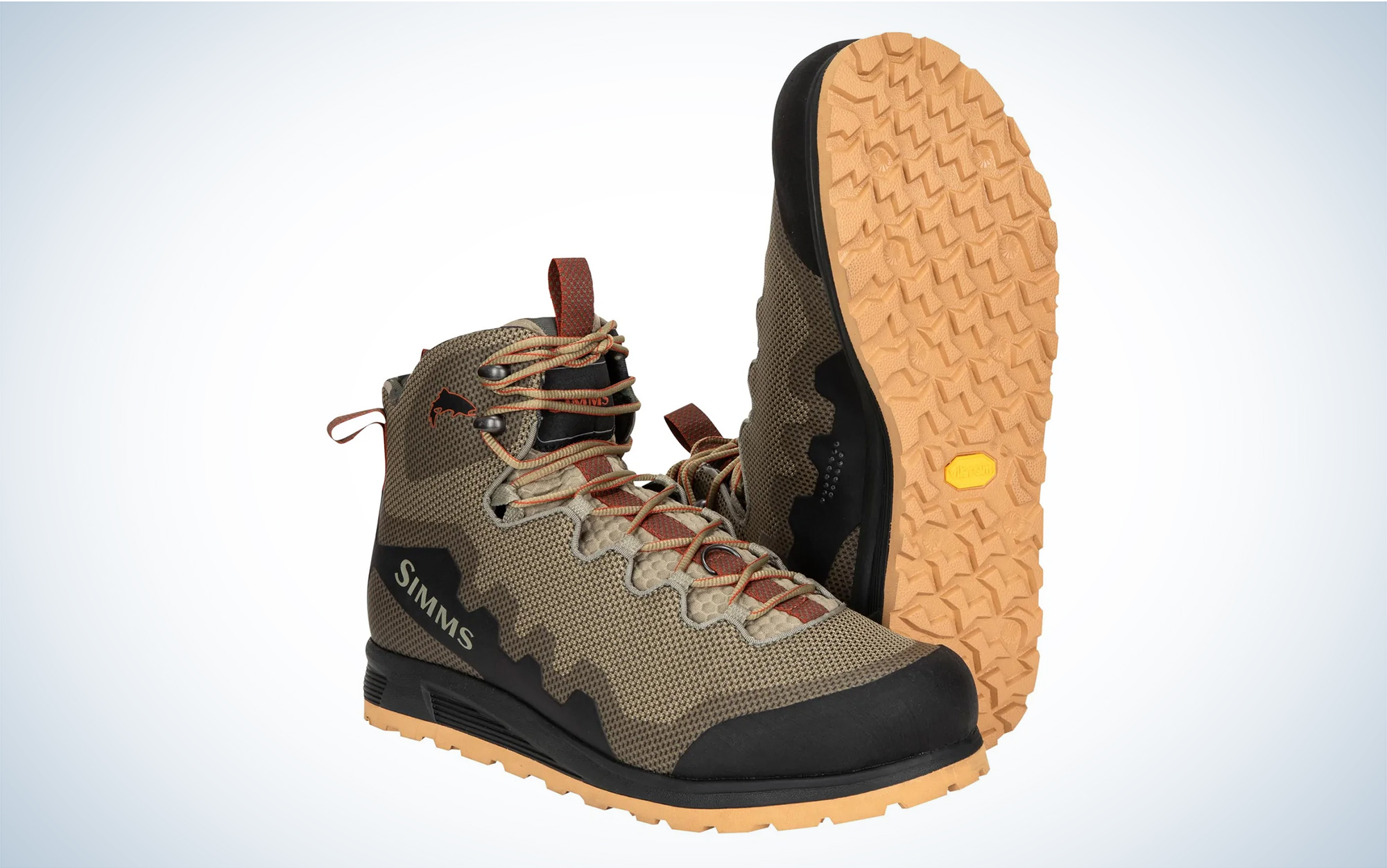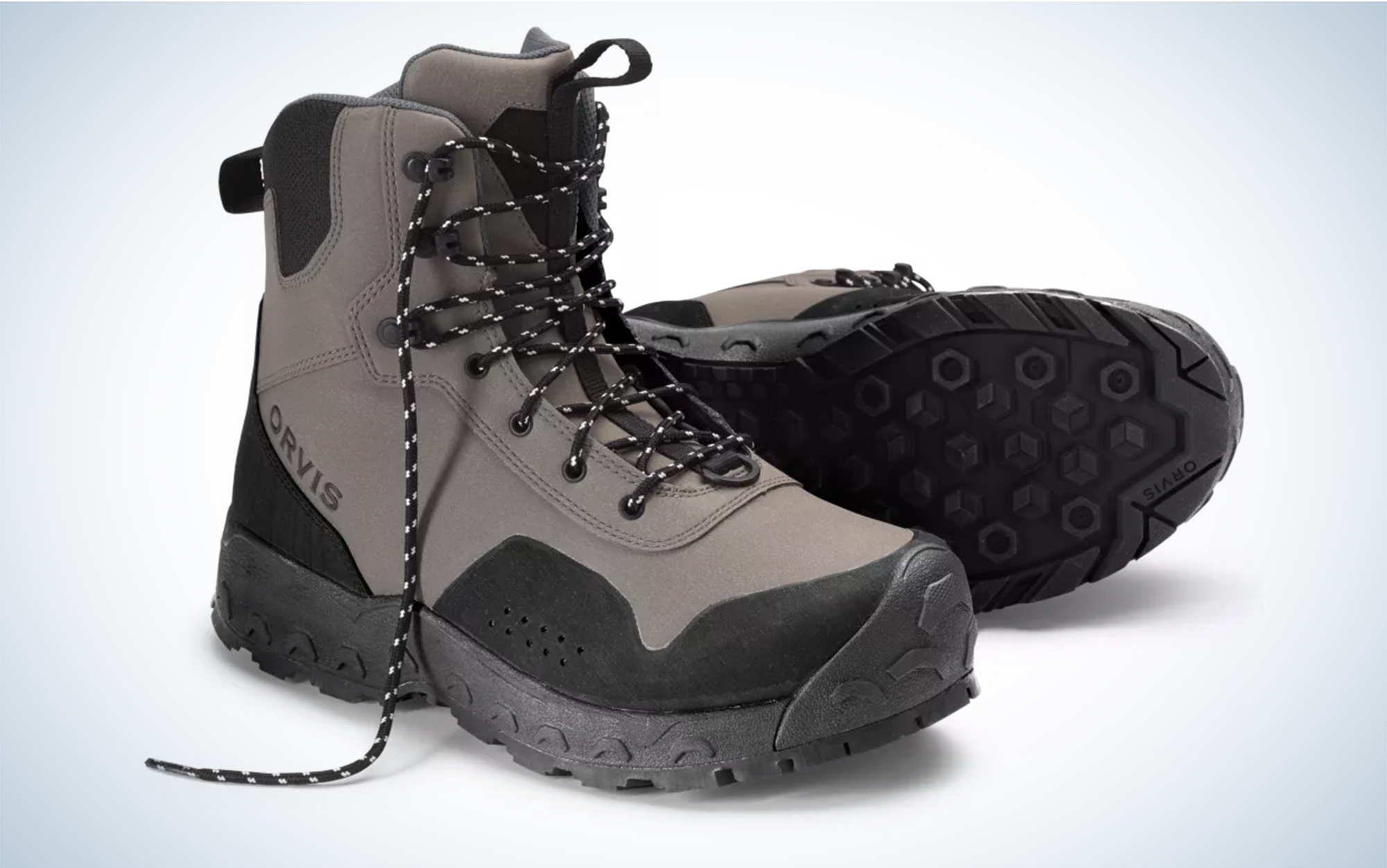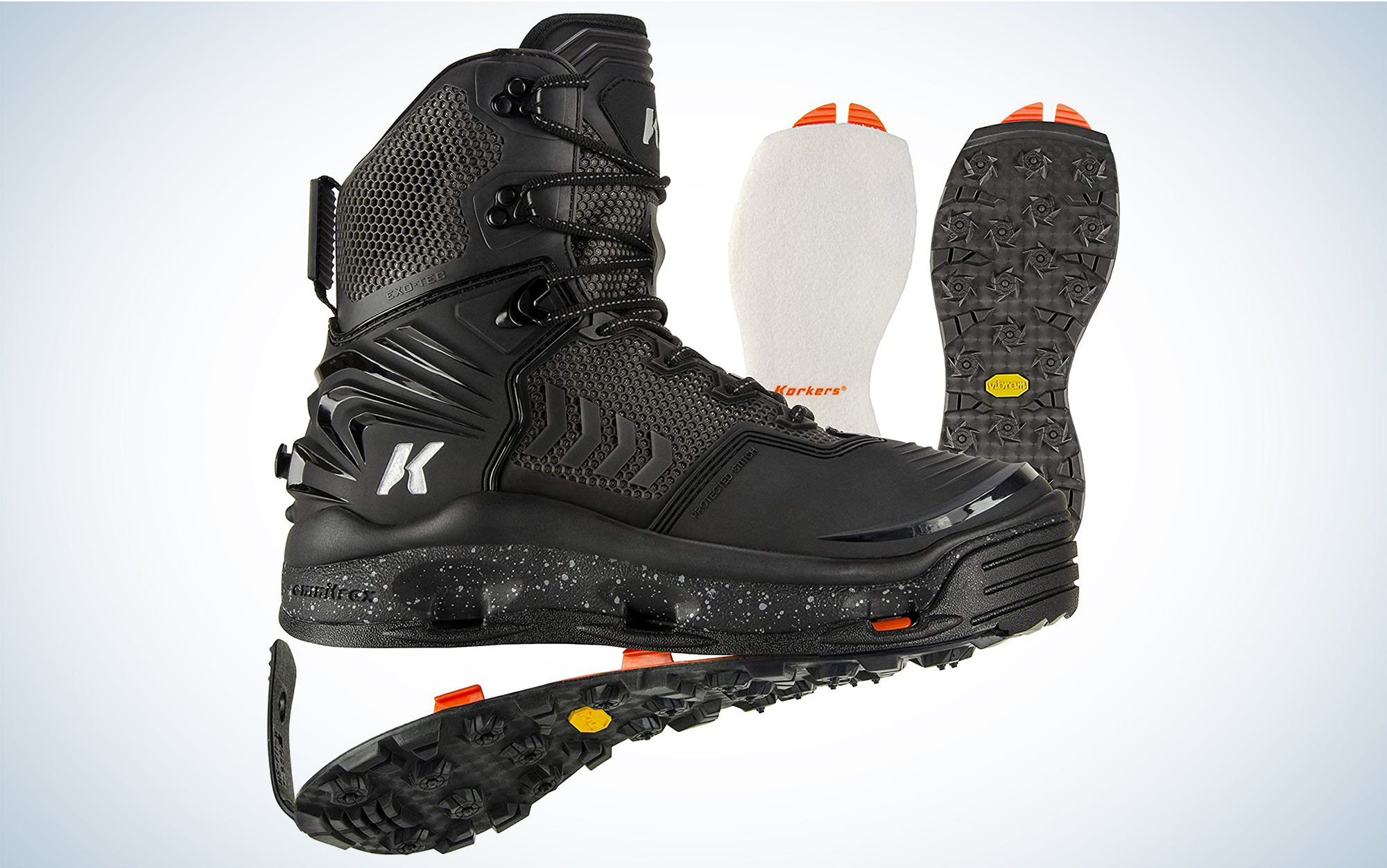We may earn revenue from the products available on this page and participate in affiliate programs.
Published Oct 4, 2022 9:33 AM
Wading boots are one of those necessary evils for anglers who ply their craft on trout streams. We can’t always cast from the bank—what’s the fun in that, anyway? So we turn to waders and wading boots to give us the needed footing in often-rocky trout water. And, because many of us fish in places where felt soles are banned (or at least frowned upon, because they have the potential to introduce aquatic invasive species from one watershed to another), we often settle for boots that don’t give the stability we need.
To find the best wading boots I tested several hard-soled options that won’t disturb sensitive trout waters and offer good fit, footing, and comfort. Here are my top picks:
Why It Made The Cut
The Orvis PRO BOA wading boot is both durable and comfortable while giving wading anglers superior grip, an adjustable fit, and an easy on-and-off BOA system that makes putting them on and taking them off a breeze.
Key Features
- BOA on/off system
- Michelin Outdoor Extreme outsole
- 3D molded OrthoLite X25 insole
- Locations for screw in studs
- Rubber toe cap
- Weight: 50 ounces
Pros
- BOA allows easy adjustment
- Great footing, even without studs, on slippery river rocks
- Quick-drying
- Comfortable
Cons
- Large profile makes them a bit bulky
- Expensive
Product Description
The Orvis PRO BOA wading boots are supremely comfortable, easy to use, and offer the best stud-free grip of all the boots I tested. As a plus, the boots’ unique-to-Orvis Michelin Outdoor Extreme outsole offers the ability to insert studs for particularly troublesome wading conditions, adding a level of flexibility for serious fly anglers.
Additionally, the boots are pretty bomb-proof. Their construction is solid, their weight isn’t offensive, even when wet, and the ability to tighten and loosen the fit to match the conditions is a real bonus. Finally, they wear well—after a half-dozen uses over two weeks, they look like they’re right out of the box. This might assuage any concerns over the boots’ price point—if they last more than a couple of seasons (and, yes, the BOA system can be easily replaced), the price tag doesn’t look so bad.

Why It Made The Cut
In this case, the name says it all. The Flyweight Access boots are lighter than other boots I tested; they drain well and dry quickly. And their Vibram soles are great on slippery stream bottoms, even without metal studs.
Key Features
- Lightweight mesh construction
- Vibram sole
- Weight: 44.7 ounces
- Welded TPU overlays in high-abrasion areas
Pros
- Flexible fit for comfortable hiking
- Quick-dying
- Comfortable—like wearing hiking boots
Cons
- Lace loops tend to fail after just a handful of uses
- Not durable
Product Description
The Simms Flyweight Access wading boots are really two boots in one. They’re serviceable wading boots with a high-end Vibram sole, and they’re a lightweight hiking boot that’s comfortable enough for long stretches on the trail between fishing holes. If you’re a wandering angler and you need something light that dries quickly and offers trail-quality comfort, these boots are your best option. They’d also be an excellent choice for hiking into small backcountry streams for wild and unpressured trout.

That said, they are likely not the boots you need if you spend hours at a time in the water, wading in tricky situations. While the Vibram sole offers great traction, there’s a trade off between the lightweight construction and durability. They also don’t offer the foot and ankle support of stiffer wading boots.

Why It Made The Cut
The Orvis Clearwater brand is synonymous with affordable quality (the Clearwater fly rod is one of the best trout fly rods), and these wading boots deliver. No, they’re not the survive-the-apocalypse wading boots you’ll need if you’re an avid angler who puts in 100 days on the water, but for budget-conscious anglers who fish frequently enough to expect a quality product, the Orvis Clearwater wading boots are a solid choice.
Key Features
- Rubber toe bumper
- Rubber sole that’s ready for metal studs
- Vents on both sides for draining
Pros
- Lace eyes rather than loops
- Sturdy and comfortable
- Great value for the price
Cons
- The rubber soles aren’t rock grabbers—screw in some studs to improve footing
- Bulky and don’t dry very quickly
Product Description

The Orvis Clearwater wading boots are a great option for value-minded anglers who don’t punish their wading boots in super demanding situations. That said, they sport quality construction and bear the Clearwater brand that Orvis uses for its price-to-value gear. The boots offer surprising comfort when worn over Neoprene booties, and they shed water well. That said, they don’t completely dry out as quickly as some other options. The toe bumper is a nice touch, and the boots are sturdy on uneven footing.
For the money (around $170) the Clearwater wading boots represent a good value for casual or beginning anglers who want something dependable without dropping a small fortune to achieve that goal.

Why It Made The Cut
Korker’s River Ops BOA wading boots combine their multi-sole option with an easy on and off system and a unique, durable “exo-skeleton” that adds value to this product.
Key Features
- Swappable sole technology
- Protective exoskeleton
- BOA system
- Vibram soles in non-felt options
Pros
- Easy on and off
- Exo-skeleton adds ankle and heel support
- Drains well and dries quickly
Cons
- The soles are great for rocks and gravel, but can come unbuttoned in mud
- Heavier than others we tested at 57 ounces
- They’re the most expensive boot we tested ($299.99 retail)
Product Description
The Korker River Ops BOA wading boot features everything you’d expect from Korkers, but also adds in some features that makes this product the right choice for folks who wear wading boots all the time (guides and anglers who fish dozens of days a year). The new and protective exoskeleton is a nice feature, and at first look, with the BOA system in place, you might think you’re looking at a ski boot.
But the boots are not perfect. The swappable sole tech is generally great, but in muddy situations, the soles can and do come unbuttoned. But, in “normal” wading situations where anglers might need a studded sole option, or, where allowed, a felt sole option, the River Ops BOA boots are a great choice.
Things to Consider Before Buying Non-Felt Wading Boots
Construction
Wading boots are often an afterthought until you’re limping back to the truck after a couple of hours trying to wade over the greased bowling balls that line the middle stretch of the Henry’s Fork. Before you buy, do your research. How boots are built matters. Consider features like toe protection, flex, and comfort while wearing Neoprene booties.
Take a good look at the products before you buy them, and try before you buy. If you’ve fished for years and been through your share of boots, you’ll know that things like the upper construction, lace eyelets, lace loops, and lace hoops are often the first things to fail. Given that most quality wading boots come with a fairly steep price tag, you’ll want to give every boot a good once-over before you plop down the cash.
Comfort
Many of us consider comfort something we can sacrifice if we can achieve reliable footing in a wading boot. The good news is wading boot manufacturers are getting better at making boots a bit more comfortable. That said, if you want serious durability, you might not have the flex in the sole you prefer, or the boot might come in on the heavy side. When considering wading boots, how you fish matters. If you’re a steelhead swinger who sidesteps downstream every four casts, you may be able to go bigger and bulkier and grabbier rather than lighter and quicker to drain. If you’re a bushwhacker or an avid hiker, you may want a lighter boot that works as well on the trail as it does in the water. But being comfortable, regardless of how you fish, matters. And, no, you shouldn’t have to sacrifice.
Affordability
It’s easy to fall back on the old adage, “You get what you pay for.” And, for the most part, it rings true when considering wading boots. More durable and longer-lasting boots for anglers who fish more than 50 days in a year are going to cost more. More basic models for more casual anglers are going to cost less.
Again, before you buy a pair of boots, think about how you fish. Do you wade rocky, backcountry streams? Do you hike a mile before you get your feet wet? Or do you fish almost exclusively from a drift boat with periodic wading thrown in? This should help you decide on the right wading boot, at the right price, for you.
Footing
This, of course, is vital, not just from a comfort perspective but from a safety standpoint. And no, not every rubber- or Vibram-soled boot is created equally. If you wade often, and can’t use a felt-soled boot, consider a boot that makes the addition of metal studs a breeze (most hard-soled boots do, but not all). Consider, too, that some boots offer the option of changing soles for multiple situations. But above all, find boots that allow you to be safe when you’re in the water. That’s paramount.
FAQs
Q: Why are felt soles banned in some places?
Felt soles are banned in many states and national parks because they have been shown to possess the nefarious ability to transport aquatic invasive species from one watershed to another. Felt soles are banned in Yellowstone National Park, and they’ve been banned in Alaska since 2012.
Q: Do I need to buy wading boots in a larger size than my normal shoe size?
No. Most wading boot manufacturers factor in the fact that anglers will likely wear their products over thicker neoprene booties. You don’t need to “size up” when you buy wading boots.
Q: Are wading boots waterproof?
Wading boots are not waterproof, but hopefully, you’re using one of the best fly fishing waders, which are. If you wet wade, your feet will get wet, because wading boots don’t keep water out. Rather, they work to shed water quickly once anglers step out of the water.
Q: Should wading boots fit tight?
Ideally, wading boots will fit your feet just like any other pair of shoes or boots you own. That said, they are also designed to provide stability and protection, so they might not be as comfortable as your favorite pair of Chuck Taylors.
Final Thoughts
The best wading boots should be grippy, comfortable, supportive, and keep our waters invasive free. The goal for most conservation-minded anglers should be to lessen the impact they have on the waters they fish, and it probably is a good idea when fishing in trout streams where native fish are present or where there is no evidence of troublesome aquatic invasive species (like whirling disease or New Zealand mudsnails) to avoid felt-soled boots. With that in mind, choose the wading boots that are best for your fishing style and for the rivers.
Methodology
I tested each pair of wading boots on a mid-sized trout stream in eastern Idaho. The stream featured slippery rocks, challenging wading conditions, and required me to move around a bit from one stretch of holding water to the next.
Each boot was tested once for about two hours, and each test involved long periods of immersion and significant out-of-the-water hiking on and off trails. Each pair of boots was allowed to air dry overnight outside.
Credit: Source link































